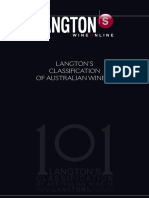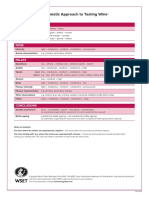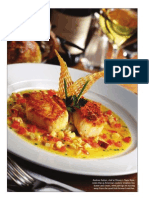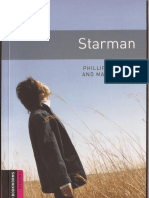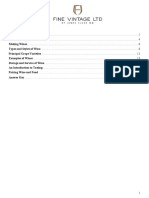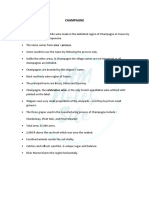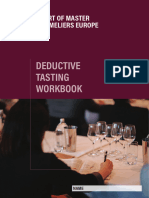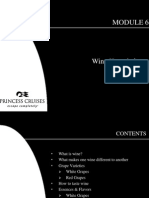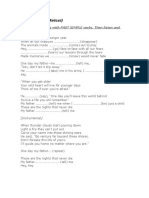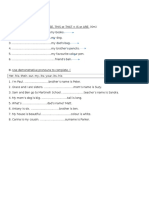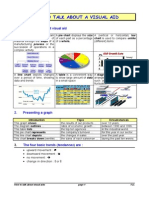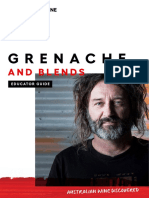Wine Tasting Vocabulary
Wine Tasting Vocabulary
Uploaded by
Julieta VillalbaCopyright:
Available Formats
Wine Tasting Vocabulary
Wine Tasting Vocabulary
Uploaded by
Julieta VillalbaCopyright
Available Formats
Share this document
Did you find this document useful?
Is this content inappropriate?
Copyright:
Available Formats
Wine Tasting Vocabulary
Wine Tasting Vocabulary
Uploaded by
Julieta VillalbaCopyright:
Available Formats
Acidity Critical component of wine: wines lacking sufficient acidity seem dull, lifeless;
excessively acidic wines are sharp or tart. Acidity is offset by residual sugar (of, for
example, so-called dessert wines) and by alcohol.
Aftertaste Sensations which remain after a wine is swallowed composed of aromas
and tastes. Synonymous with finish. The best wines possess persistent, complex
aftertastes.
Alcohol Primary component, mainly responsible for body or weight; also contributes
to aroma and plays an important role in balancing acidity and tannin. Has a sweet
taste.
Aroma Olfactory sensations vital to perception and pleasure of wine and derived
primarily from fermentation. Aroma is perceived directly when holding a glass to the
nose, and through the retro nasal passages when the wine is in the mouth.
Customarily, the nose of a young wine is termed aroma while that of a mature or aged
wine is described as bouquet.
Astringent Dry, puckering sensation in the mouth usually caused by tannin. Tannins
are typical of red wines intended for bottle aging; they tend to soften with time.
Balance A good wine exhibits harmony or balance of constituent parts. Some wines
may only come into balance with aging in bottle.
Bitter Unpleasant taste to most people. Although sensitivity varies widely, the most
acute palates are often the most sensitive. Tannins may be perceived as bitter by some
tasters.
Body The fullness or weight of a wine mainly due to its alcohol content. Neither
positive nor negative; certain types of wines tend to be light-, medium- or full-bodied.
Bouquet The smell of an aged or mature wine; very different from that of a young
wine. See aroma.
Clean Free of off-odors and tastes, a desirable quality. However, potential faults (for
example, volatile acidity) may add to complexity at low concentrations.
Closed Commonly employed metaphor for a wine which expresses little of its inherent
flavor characteristics because the wine is young, or because of its stage of
development.
Coarse A negative term referring to a poorly made wine, often aggressively rough.
Complexity A highly desirable if elusive attribute of wine, referring to the range of
aromatic and taste sensations. The greatest wines offer heightened complexity.
Concentration Volume of constituent elements, notably dry extract and alcohol; the
intangible sense of raw material at the core of a wine. See also substance.
Wine Tasting
Vocabulary
1
Corked The unattractive odor of a wet cork caused mainly by 2,4,6-trichloroanisole
(TCA) or related compounds. Other forms of taint may often be falsely identified as
corkiness. The incidence of corked wine has been reduced by improvements in cork
sterilizing procedures.
Delicate Positive descriptor of appealing light wines.
Depth Refers to the impression of overall flavor; the most impressive wines have depth
while great classics are profound.
Dry Opposite of sweet. How dry a wine is perceived to be depends on other
components, and the taster. Aside from obvious exceptions (late harvest dessert or
selected fortified wines such as Port or Cream Sherry), the vast majority of wine is dry.
Unfortunately, this fundamental term is misunderstood by many consumers.
Elegant An imprecise, metaphorical term to describe a finely balanced wine; often
used in conjunction with finesse.
Fine A wine of excellent quality.
Finesse Attribute of delicate, well-balanced wines. Usually not used for powerful
wines. See elegant.
Finish Sensations which linger on the palate, referring both to their intensity and
complexity. See aftertaste.
Firm Dry, sometimes somewhat astringent finish. Usually positive, a firm wine is well
structured; a wine which appears overly firm is rough or even hard.
Flowery Attractive aroma of certain wines resembling flowers when very young.
Fresh Positive trait of a young white or red wine possessing noticeable acidity.
Fruity The aromatics of young wines which tasters associate with fruits (apple, lemon,
raspberry, etc.). Most youthful wines may be described as fruity to varying degrees,
unless they are dominated by oak. Fruity is not synonymous with sweet.
Hard Severe, assertively dry or astringent; may dissipate with aging.
Length The amount of time the aftertaste or finish remains in the mouth and nasal
passages. A wine may be described as short or long.
Light Possessing little body; may simply be the character of the wine type (Muscadet
or Mosel Riesling), or it may be a demerit for wines which should have more body.
Long Flattering descriptor for a wine having a persistent, lasting finish.
Minerality The invented English equivalent of a French word favored by some tasters
to describe a dry wine with stony flavors akin to a salty mineral water (which
contains dissolved solids leached from soil). Scientists dispute the direct conversion of
soil chemical constituents into specific wine taste characteristics. To be used with care.
Neutral Lacking discernible taste characteristics. Typical of many ordinary mass market
wines, especially whites (e.g., Pinot Grigio).
Oaky Strongly marked by maturation in oak barrels: woody, spicy, vanilla, coconut, etc.
Wine Tasting
Vocabulary
2
Powerful Mouth-filling, full-bodied, vigorous wine, usually with elevated alcohol
content.
Quality The most challenging term of all: the degree to which a wine satisfies the
standards of its origin, type and price. Knowledge and experience are needed to assess
quality; a professional taster should be able to distinguish quality from personal
preference. Conversely, a beginner equates his or her own individual taste response
with the merits of the wine.
Rich Generously endowed with flavor; most likely ripe and full-bodied.
Ripe Exhibiting qualities of grapes harvested when fully but not overly mature.
Rough Astringent to some extent, but short of coarse. Roughness may be a function of a
wines youthfulness; a rough wine may become soft with age.
Round Feel in the mouth indicating subdued acidity together with a soft center.
Severe Hard and very firm. Severe wines will probably not improve with keeping as they
may also be imbalanced.
Soft Antithesis of astringent, rough or hard. A soft wine may be appealingly smooth or
velvety in texture; conversely, it could lack acidity.
Spicy Most spices in wine come from wood barrels, not from the grapes; for example,
cinnamon, cloves, pepper. Compounds which tasters describe as vanilla and smoke
similarly originate largely from oak.
Style Describes the specific context of a wine, as in light, dry, unoaked or full bodied,
rich and barrel aged. Distinct from quality. However, stylish refers to a fine, elegant
wine.
Substance Comprehensive descriptor for the combined impression of the body and
flavor of a wine.
Supple Pleasing textural quality of red wines implying a certain softness on the palate;
not hard or severe.
Sweet Noticeable sugar, usually remaining after fermentation or from added
concentrate in popular mass market wines. Sweetness may be concealed by acidity.
Alcohol also has a sweet taste, although it is rarely identified as such. Surprisingly, the
core concept of sweet vs. dry eludes many novice wine drinkers.
Tannin An important component of red wine especially, particularly those intended for
cellaring; with bottle aging, tannins are polymerized and eventually fade, losing their
astringent or rough textural imprint. Collectible red wines (top Bordeaux, Cabernet
Sauvignon, Hermitage, Barolo, Brunello) normally possess high tannin levels facilitating
the aging process and giving them potentially long lives in bottle.
Thin Watery, lacking flavor interest and body.
Weak Lacking character and flavor; similar to thin.
Weight Synonym for body and a fundamental descriptor. Weight varies as a function of
grape variety, climate, vintage and wine style.
Young A wine exhibiting any number of flowery, fruity and/or fresh characteristics.
Some wine types and individual wines may retain youthful characteristics even after
several years in bottle.
Wine Tasting
Vocabulary
3
You might also like
- WSET Level 3 Systematic Approach To Tasting WineDocument2 pagesWSET Level 3 Systematic Approach To Tasting WineDallas Bergen85% (13)
- Wset Level 2Document63 pagesWset Level 2Jason-chung33% (3)
- Winery Business PlanDocument53 pagesWinery Business PlanChuck Achberger100% (8)
- WSET - L3 Spirits - Study GuideDocument36 pagesWSET - L3 Spirits - Study GuideMVSA餐飲部0% (1)
- Court of Master Sommeliers Europe Prospectus 2024Document21 pagesCourt of Master Sommeliers Europe Prospectus 2024junior couto100% (1)
- French Wine Scholar - Sample Côte Du Rhône PDFDocument34 pagesFrench Wine Scholar - Sample Côte Du Rhône PDFVillafranca Laura100% (3)
- 1 FAB032 EVT 001 Australian Wine Familiarisation Project 1Document8 pages1 FAB032 EVT 001 Australian Wine Familiarisation Project 1paperalta4528valNo ratings yet
- Langton's Classification Guide PDFDocument64 pagesLangton's Classification Guide PDFericwc123456No ratings yet
- Foundation Study Guide 06-07Document58 pagesFoundation Study Guide 06-07Joao Rico100% (5)
- WSET 2 Spirits Study GuideDocument26 pagesWSET 2 Spirits Study GuideFloris50% (4)
- WSET Level 3Wine-Lexicon: Supporting The WSET Level 3systematic Approach To Tasting Wine®Document2 pagesWSET Level 3Wine-Lexicon: Supporting The WSET Level 3systematic Approach To Tasting Wine®Michael Tselepis100% (1)
- WSET 3 - Detailled ContentsDocument6 pagesWSET 3 - Detailled ContentsLNo ratings yet
- Foundation Level WSET EngDocument2 pagesFoundation Level WSET EngDimitrios Christos Siotas100% (6)
- Wset Level 4 SatDocument2 pagesWset Level 4 SatL100% (1)
- WsetDocument32 pagesWsetAndrija BabićNo ratings yet
- CMS Deducive Tasting FormatDocument1 pageCMS Deducive Tasting FormatHelena GarciaNo ratings yet
- Level 3 Award in Wines SpecificationDocument33 pagesLevel 3 Award in Wines SpecificationBREAZ PETRU LUCIAN80% (5)
- Test ElementaryDocument4 pagesTest ElementaryJulieta Villalba50% (2)
- WSET L3 Wine LexiconDocument23 pagesWSET L3 Wine LexiconJCR78% (9)
- Deductive Tasting WorkbookDocument16 pagesDeductive Tasting WorkbookHtin Lin Kyaw100% (1)
- Wset l2 Spirits SpecificationDocument28 pagesWset l2 Spirits Specificationyudhi100% (1)
- WSET 3 - Systematic Approach To Tasting Wine SAT (2016)Document2 pagesWSET 3 - Systematic Approach To Tasting Wine SAT (2016)FleerNo ratings yet
- Deductive Tasting Grid CMSDocument1 pageDeductive Tasting Grid CMSNick LafontNo ratings yet
- Exploring The World of Wines and SpiritsDocument42 pagesExploring The World of Wines and SpiritsÖzgecan Cesur100% (2)
- Wine Tasting For Beginners v3.1Document39 pagesWine Tasting For Beginners v3.1Vera100% (2)
- WSET Level 1 Notes 3Document1 pageWSET Level 1 Notes 3Thiago OliveiraNo ratings yet
- Wine and Food PairingsDocument6 pagesWine and Food Pairingsapplejak100% (3)
- Deductive Tasting Grid Dec 2016Document1 pageDeductive Tasting Grid Dec 2016stanciu virgilNo ratings yet
- Tasting - Spirits DiplomaDocument2 pagesTasting - Spirits Diplomasunseton32nd100% (1)
- Starman Book PDFDocument22 pagesStarman Book PDFJulieta Villalba100% (1)
- Pocket Sommelier - Wine Tasting GuideDocument13 pagesPocket Sommelier - Wine Tasting GuidePocket100% (3)
- WSET Level 1 Element 1Document14 pagesWSET Level 1 Element 1Manya100% (2)
- Wine Tasting TermsDocument6 pagesWine Tasting TermsLukeni AraujoNo ratings yet
- Red WinesDocument24 pagesRed WinesMarin GarazNo ratings yet
- Oz Clarke Wine by the Glass: Helping you find the flavours and styles you enjoyFrom EverandOz Clarke Wine by the Glass: Helping you find the flavours and styles you enjoyNo ratings yet
- Vines for Wines: A Wine Lover's Guide to the Top Wine Grape VarietiesFrom EverandVines for Wines: A Wine Lover's Guide to the Top Wine Grape VarietiesNo ratings yet
- Australia Wine RegionsDocument56 pagesAustralia Wine RegionsShiva Chaurasiya100% (1)
- Wset L2wines Specification en May2023 Issue2Document29 pagesWset L2wines Specification en May2023 Issue2vish A100% (1)
- CMS Certified Exam-Deductive Tasting FormatDocument1 pageCMS Certified Exam-Deductive Tasting FormatNabenduSahaNo ratings yet
- Deductive Tasting JournalDocument50 pagesDeductive Tasting Journalstanciu virgilNo ratings yet
- Cms Certified Exam-Service Standards2Document5 pagesCms Certified Exam-Service Standards2api-246293177No ratings yet
- WSET Level 1 Self Study QuestionsDocument26 pagesWSET Level 1 Self Study QuestionsChloe100% (2)
- WSET Level 1 Self Study QuestionsDocument25 pagesWSET Level 1 Self Study QuestionsChloe50% (2)
- WSET Level 2 in Wines - Sample Quiz - PassWSETDocument1 pageWSET Level 2 in Wines - Sample Quiz - PassWSETmoonhalfbabyNo ratings yet
- Level 2 Spirits Sat English A5 2013Document2 pagesLevel 2 Spirits Sat English A5 2013Anonymous qcveG7KC100% (2)
- 2020-03-21 Week 12.2 Revision Week Tasting - 1Document6 pages2020-03-21 Week 12.2 Revision Week Tasting - 1jextxadoreNo ratings yet
- Wset 4 SAT and Recommended WinesDocument7 pagesWset 4 SAT and Recommended WinesbrimstonecrimsonNo ratings yet
- 12 ChampagneDocument7 pages12 ChampagnenimishsdNo ratings yet
- Wset L3spirits Specification en Jun2020Document36 pagesWset L3spirits Specification en Jun2020Ricardo SeverimNo ratings yet
- Deductive Tasting Workbook 16pp FA DigitalDocument17 pagesDeductive Tasting Workbook 16pp FA Digitalesmeralda.reynothNo ratings yet
- Examination Regulations WSET Level 2Document3 pagesExamination Regulations WSET Level 2Anonymous qcveG7KCNo ratings yet
- Burgundy: Staff Training ModuleDocument14 pagesBurgundy: Staff Training ModuleFloris100% (1)
- Wine CourseDocument28 pagesWine Coursejoanne_ebook100% (3)
- LVL 1 Wine Sample Questions & TipsDocument2 pagesLVL 1 Wine Sample Questions & TipsaalalalNo ratings yet
- The Wines of FranceDocument10 pagesThe Wines of Francenimishsd100% (1)
- l1 Wines Spec 2012 EngDocument20 pagesl1 Wines Spec 2012 EngisabelabenammorNo ratings yet
- CMS Introduction To Winemaking PDFDocument18 pagesCMS Introduction To Winemaking PDFJose Benito Morales GarciaNo ratings yet
- Pocket SommellierDocument64 pagesPocket Sommelliersbistaff100% (1)
- Certified Sommelier Examination Tasting Module Candidate InstructionDocument3 pagesCertified Sommelier Examination Tasting Module Candidate Instructionjunior couto100% (1)
- Funway Tests 2Document18 pagesFunway Tests 2Julieta Villalba100% (1)
- Grammar PracticeDocument178 pagesGrammar PracticeJulieta VillalbaNo ratings yet
- Progress Test 1market LeaderDocument5 pagesProgress Test 1market LeaderJulieta VillalbaNo ratings yet
- Starman BookDocument22 pagesStarman BookJulieta VillalbaNo ratings yet
- "The Nights" (Avicci) : Complete The Song With PAST SIMPLE Verbs. Then Listen and CheckDocument1 page"The Nights" (Avicci) : Complete The Song With PAST SIMPLE Verbs. Then Listen and CheckJulieta VillalbaNo ratings yet
- First Certificate Test 1 Units 1-5 Complete First CertificateDocument3 pagesFirst Certificate Test 1 Units 1-5 Complete First CertificateJulieta Villalba100% (1)
- English Practice TestDocument4 pagesEnglish Practice TestJulieta VillalbaNo ratings yet
- READER: Twenty Thousand Leagues Under The Sea Test 1 - Chapters 1-4Document2 pagesREADER: Twenty Thousand Leagues Under The Sea Test 1 - Chapters 1-4Julieta VillalbaNo ratings yet
- Review Test 1Document1 pageReview Test 1Julieta VillalbaNo ratings yet
- Starman - Speaking TestDocument2 pagesStarman - Speaking TestJulieta VillalbaNo ratings yet
- Another Alternative To The Office: Progress Test 2-Hamburg Sud Mendoza Intermediate LevelDocument3 pagesAnother Alternative To The Office: Progress Test 2-Hamburg Sud Mendoza Intermediate LevelJulieta VillalbaNo ratings yet
- Graphs DescriptionDocument4 pagesGraphs DescriptionJulieta VillalbaNo ratings yet
- Our Annual List of Must-Have Wines.: by The Editors of Wine Enthusiast MagazineDocument10 pagesOur Annual List of Must-Have Wines.: by The Editors of Wine Enthusiast MagazineLuiz Cola100% (1)
- Classic Cocktails Via ClementDocument2 pagesClassic Cocktails Via ClementJason McCoolNo ratings yet
- Roberts Fine Wines PortfolioDocument20 pagesRoberts Fine Wines PortfolioGreg RobertsNo ratings yet
- WST Level 1Document19 pagesWST Level 1MTNo ratings yet
- Wine Enthusiast Buying Guide 2012Document75 pagesWine Enthusiast Buying Guide 2012katschornberg100% (1)
- Wood & Beer - A Brewer's Guide (2016)Document253 pagesWood & Beer - A Brewer's Guide (2016)Ismael Possamai100% (1)
- Hawaii Beverage Guide 02-12Document50 pagesHawaii Beverage Guide 02-12Christopher TevesNo ratings yet
- 2013 Decanter Juin ST Chinian & FaugeresDocument4 pages2013 Decanter Juin ST Chinian & FaugeresPaul GordonNo ratings yet
- The Wines of Sula VineyardsDocument36 pagesThe Wines of Sula VineyardsMakarandkolekarNo ratings yet
- Choosing Guides Oak TanninDocument1 pageChoosing Guides Oak Tannin임광수No ratings yet
- Raw Materials and ProductsDocument4 pagesRaw Materials and ProductsDarren Ian MaalihanNo ratings yet
- Glossary of Wine TermsDocument30 pagesGlossary of Wine Termsnitin0010No ratings yet
- BarcosWines Presentation Mar2023 enDocument18 pagesBarcosWines Presentation Mar2023 enkhanh fribaultNo ratings yet
- Plan Proiect Crama Engl.Document49 pagesPlan Proiect Crama Engl.Anonymous gnGxwilWzNo ratings yet
- The Barrels & AOP Industry 2021Document47 pagesThe Barrels & AOP Industry 2021Bastien AlletruNo ratings yet
- WineDocument3 pagesWinetcusesthisforschoolNo ratings yet
- AWD Grenache GuideDocument41 pagesAWD Grenache GuideJesse CassNo ratings yet
- Test 1 HSG 11 HSDocument13 pagesTest 1 HSG 11 HSnọcNo ratings yet
- Wynns Michael Shiraz 2005Document1 pageWynns Michael Shiraz 2005ericwc123456No ratings yet
- AWD IntroToWine Powerpoint 1Document54 pagesAWD IntroToWine Powerpoint 1thành JvNo ratings yet
- Domaine Nerantzi - PresentationDocument6 pagesDomaine Nerantzi - PresentationLakis Takis PapasNo ratings yet
- Document 1Document16 pagesDocument 1alexrocho3No ratings yet
- La Mama Wine Menu PDFDocument4 pagesLa Mama Wine Menu PDFDaniela CookeNo ratings yet
- Catalogo Bernavi - eDocument5 pagesCatalogo Bernavi - eCarlos GrandeNo ratings yet
- FSM 117 Wine PairingDocument5 pagesFSM 117 Wine PairingBenjamin TaduranNo ratings yet







